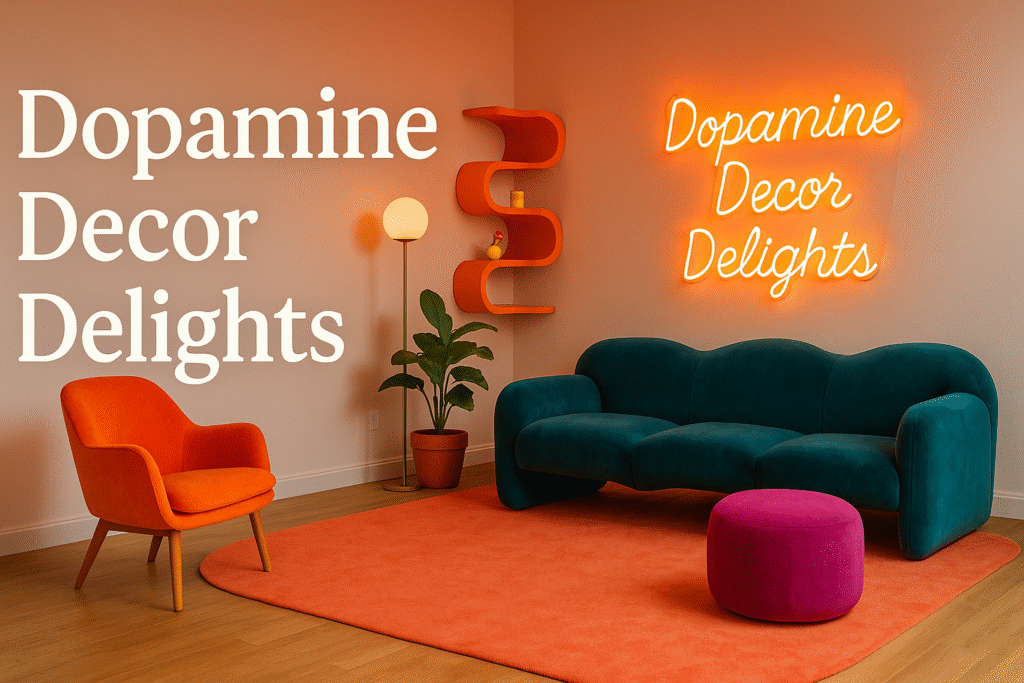It starts with a hit of colour. Maybe it’s a bright orange chair, maybe it’s a flamingo-pink wall that wasn’t there yesterday. Maybe it’s a squiggly rug you found in a second-hand shop, and the moment you laid it down, the room changed. Your body knows it before your brain catches up—something in this space feels happier, bolder, strangely more you. That’s the essence of dopamine decor.
This isn’t your average design trend. Dopamine decor is less about pleasing Pinterest algorithms and more about pleasing your own emotional chemistry. Think colour that lifts your mood, patterns that feel like play, textures that you want to touch twice. Every choice is wired to trigger joy, whether through nostalgia, surprise or simply your favourite shade of yellow. In a world that often feels grey, dopamine decor says: fill your home with what makes you smile, unapologetically.
Where colour meets chemistry
Dopamine is the brain’s feel-good neurotransmitter, the tiny spark behind every “aha” moment, every accomplishment, every grin you can’t quite explain. Neuroscientists say when we see something beautiful, our reward system lights up, activating the same pathways that make us crave connection, movement, even chocolate. Now imagine your living room activating those same pathways. That’s not just paint on the walls, that’s design with intention.
Designers are catching on fast. The dopamine decor movement surged in 2024 when TikTok exploded with maximalist makeovers and colour-drenched transformations. Hashtags like #dopaminedecor have clocked up millions of views, inspiring people to swap beige minimalism for energy, whimsy, and walls that look like sunsets. It’s no coincidence this trend bloomed when many of us were seeking comfort inside our homes, craving spaces that didn’t just look good but felt good.
The feel-good formula
There’s no single blueprint for dopamine decor, because it’s deeply personal. What lights up one person’s brain might leave another feeling overwhelmed. Still, a few common threads tie the style together:
- Vibrant colour: Citrus tones, turquoise, magenta, marigold—there’s no need to hold back. Dopamine decor thrives on hues that energise you. Even softer colours like blush or mint can serve the same purpose when they’re paired with joy-inducing accents.
- Textures and curves: A chunky knit blanket, a velvet sofa, wavy shelves that look like they’re from a dream. Our brains prefer curved shapes to harsh lines, and textured materials offer a sensory depth that flat, sterile surfaces lack.
- Personal story: A gallery wall filled with your own snapshots. A vase you picked up in Lisbon. A cushion your grandmother stitched. This isn’t fast decor, it’s slow joy—pieces that tell your story, not the catalogue’s.
- Unexpected elements: Think a neon sign in the hallway, a disco ball in the bathroom, a mushroom lamp that looks straight out of a fantasy novel. Dopamine decor welcomes the odd, the playful, the bold.
Why it works
At its heart, dopamine decor is about designing from the inside out. Instead of asking “What’s in style?”, it asks “What makes me feel alive?” Colour psychology backs this up—warm tones can boost energy and sociability, while specific textures and lighting can reduce stress or increase focus. It’s a full-body experience, and it’s hardwired into our biology.
More importantly, it gives us permission. Permission to make “clashing” choices that actually feel perfect, permission to mix granny florals with modern geometry, permission to break the rules. Because rules don’t release dopamine. Play does.
Real spaces, real joy
You’ll see dopamine decor done big in designer homes—mint green ceiling tents, coral rugs, checkerboard tiles—but you don’t need a massive budget to start. Some of the best transformations begin with a single statement item: a tangerine lamp, a velvet pouf, even a painted doorframe in peacock blue. In one London flat, a tired fireplace got a £600 facelift using citrus tiles, framed art and a collection of flea-market finds. The result? A room that felt more alive than it had in years.
The trend has even seeped into workplace design, with offices swapping grey break rooms for lounges filled with pastel murals and plant walls. Early studies suggest these colourful changes don’t just boost employee satisfaction—they increase alertness and creative output too.
How to bring dopamine decor into your home
Start by trusting your gut. If something makes you smile in the shop or on a scroll, take note. You don’t need to follow a palette, but you do need to follow your instincts.
Do a “joy walk” through your home. What are the pieces that spark happiness? What feels flat or sterile? Sometimes, it’s as simple as swapping beige curtains for saffron ones, or replacing a mass-market print with your friend’s artwork.
Layer in small changes. Try a new wall colour on just one accent wall. Buy bold cushion covers before changing the whole sofa. Add a squiggle mirror or a candy-coloured kettle. Dopamine decor doesn’t demand perfection or speed. It invites you to play.
Even better, dopamine decor can overlap with sustainability. Thrifting for vintage furniture, repurposing old linens into tablecloths, or repainting a tired bookshelf in bubblegum pink—it’s all about joyful reuse, not endless consumption.
When is too much, too much?
Some critics say dopamine decor can feel overwhelming, especially in spaces meant for rest. They’re not wrong. Bedrooms may need softer tones, fewer visual distractions. The secret is contrast. Let your living room sing with colour, then let your bedroom hum quietly. Or keep high-saturation elements in places where you want a mood lift—an entryway, a kitchen, a studio.
Balance comes from grounding. One wall in lime green might work beautifully if the rest of the room stays warm and neutral. You can still play with dopamine decor without turning every inch into a carnival.
The future of feel-good design
Interior forecasts for 2025 place dopamine decor high on the charts. Global home spending is up, colour-rich paint lines are dominating collections from brands like Sherwin-Williams and Dulux, and retailers report dopamine-inspired wall art as top sellers. More importantly, there’s been a cultural shift. Home is no longer a showplace for trends. It’s a safe space for self-expression.
Maybe the best part of dopamine decor is that it doesn’t belong to one era, one mood board, or one type of house. It’s more like a permission slip—one you write for yourself. A nudge to choose joy, to celebrate colour, to let your home become not just a place to live, but a place that lives with you.


